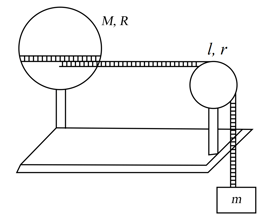A spool (consider it as a double disc system joined by a short tube at their centre) is placed on a horizontal surface as shown in figure. A light string wound several times over the short connecting tube leaves it tangentially and passes over a light pulley. A weight of mass m is attached to the end of the string. The radius of the connecting tube is r and mass of the spool is and radius is . Find the acceleration of the falling mass . Neglect the mass of the connecting tube and slipping of the spool.
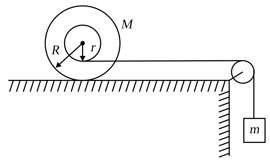


Important Questions on Rigid Body Dynamics: Part 2
A uniform solid cylinder of mass , rests on two horizontal planks. A thread is wound on the cylinder. The hanging end of the thread is pulled vertically down, with a constant force . Find the maximum magnitude of the force , which still does not bring about any sliding of the cylinder, if the coefficient of friction between the cylinder and the planks is equal to . What is the acceleration , of the axis of the cylinder, rolling down the inclined plane?
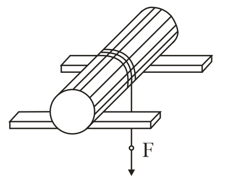
A solid sphere of mass is placed on the top of a plank of the same mass, after giving an angular velocity at . Find the velocity of the plank and the sphere when the sphere starts rolling.
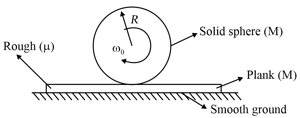
A rod of mass spins with an angular speed , Find its
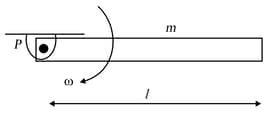
(a) kinetic energy of rotation.
(b) kinetic energy of translation
(c) total kinetic energy.
Find of the rotating composite rod comprising two rods of mass and and each of length . Assume rad and .
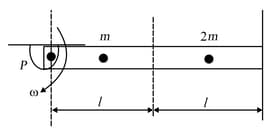
A uniform rod smoothly pivoted at one of its ends is released from rest. If it swings in vertical plane, find the, maximum speed of the end of
the rod.

A rigid body is made of three identical uniform thin rods each of length fastened together in the form of letter The body is free to rotate about a fixed horizontal axis that passes through one of the legs of the The body is allowed to fall from rest from a position in which the plane of is horizontal. What is the angular speed of the body, when the plane of is vertical.
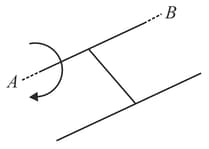
A uniform spherical shell of mass and radius rotates about a vertical axis on frictionless bearing. A massless cord passes around the equator of the shell, over a pulley of rotational inertia and radius and is attached to a small object of mass that is otherwise free to fall under the influence of gravity. There is no friction of pulley's axle; the cord does not slip on the pulley. What is the speed of the object after it has fallen a distance from rest? Use work-energy considerations.
